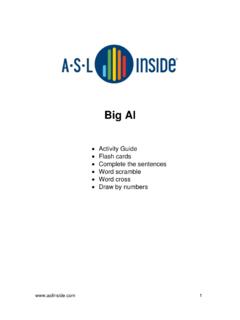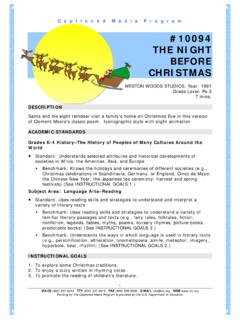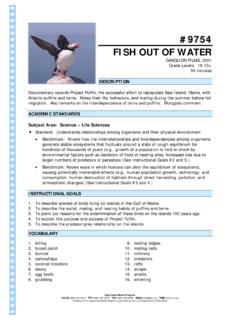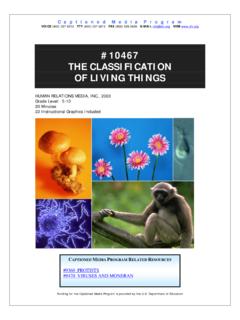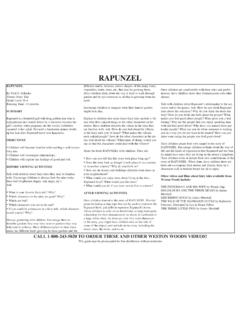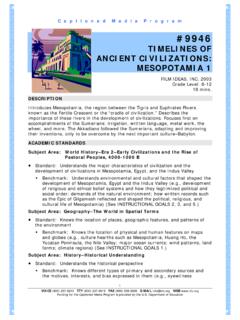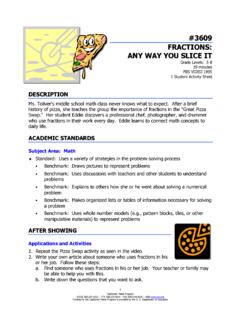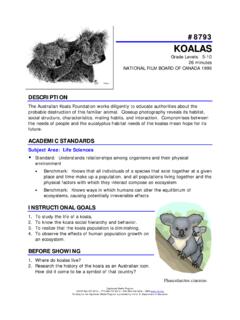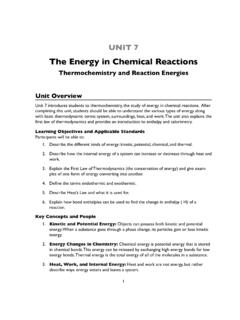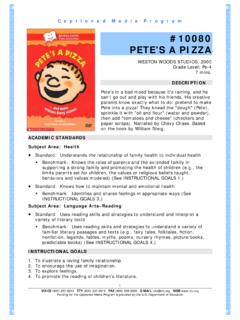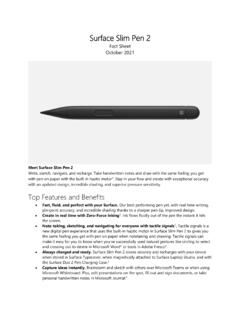Transcription of Shape and Form in Art - DCMP
1 Shape and form in Art Instructional Program for Grades K-4 Teacher s Guide Written by: Susan Freifeld 2005 Getting to Know, Inc. 2 Shape and form in Art Instructional Program for Grades K-4 Teacher s Guide Contents Introduction and Student Chapter Topics from the Hands-on Activities* 1st 2nd 3rd and 4th Reproducible Handout Designs from Shape and form ,11 Books and Conclusion and Review National Content Standards for Visual Arts Education, Grades *Correlated to the National Content Standards for Visual Arts Education, Grades K-4 3 Shape and form in Art Instructional Program for Grades K-4 Introduction This delightful program covers basic information about Shape and form in art for early elementary students.
2 Colorful animated sequences define Shape and form . Other topics include: geometric and organic shapes, Shape and form in the world around us, Shape in painting, form in sculpture, Shape and pattern, negative and positive shapes, and Shape as a tool for drawing. Additional titles in the series include Line in Art and Color in Art. Student Objectives (Correlated to the National Standards for Visual Arts Education) After viewing the program, students should be able Understand that Shape and form are an important part of the world around us, and important elements of art. (Content Standard 2) Identify and define geometric and organic/freeform/biomorphic shapes. (Content Standard 5) Understand the difference between Shape and form and the difference between 2D and 3D.
3 (Content Standard 5) Notice various types of shapes in the natural world. (Content Standards 2, 6) Explain how Shape and form are used in the compositions of paintings and sculptures. (Content Standard 3, 4, 5) Define symmetry (simple bilateral) and recognize it s use in masks and other art works. (Content Standard 3, 4, 5) Define and recognize negative and positive shapes. (Content Standard 3, 4, 5) Recognize and create patterns and motifs. (Content Standard 2, 6) Identify and utilize Shape as a tool for drawing. (Content Standard 1) 4 Shape and form in Art Chapter Topics from the Program 1. What is Shape ? What is form ? 2. Kinds of Shapes and Forms 3. Shape and form in the World Around Us 4. Shape in Painting 5. form in Sculpture 6.
4 The Human Shape and form in Painting and Sculpture 7. Shape and Pattern 8. Negative and Positive Shapes 9. Shape as a Tool for Drawing 10. Conclusion and Review 5 Shape and form in Art Hands-on Activities Kindergarten You may want to create a variety of prepared tubs for kindergarten art centers, many of which help teach about Shape and form . These activities are very open-ended, with few instructions to follow, and therefore they make a good balance for more complex art activities with many directions and steps. Kindergarteners will naturally create patterns with all of the following activities, and correlations to hands-on kindergarten math will be strong. Use of Shape Templates Find large plastic Shape templates and stencils to put into a tub with colored pencils and thin markers and plenty of paper.
5 (Content Standards 1, 2, 6) Shape Stamping and Sponging Offer stamps and/or sponges in Shape varieties, with stamp pads or trays with small puddles of washable tempera paint. (Content Standards 1, 2, 6) Shape Magnets and/or Felt Boards Lakeshore Learning (see the Books and Sites section of this guide for the website) or other early childhood catalogues offer products such as magnet boards and/or felt boards, which can be assembled to create images. (Content Standards 1, 2, 6) Foam or Wood Shapes with glue on board Cut a variety of poster board sizes, and offer these with foam and/or wood shapes for image creation. (Again, foam or wood shapes are in the school catalogues.) (Content Standards 1, 2, 6) Sketching Animals from Shapes If you demonstrate step-by-step drawing from shapes, kindergarteners are ready for this, especially as the year progresses.
6 Books by Ed Emberley, and other simple drawing books (topics could include animals or vehicles, or cartoon characters such as Pokemon, or any other high-interest are available) can be used. Put these in a tub with a variety of drawing materials. (Content Standards 1, 2, 3) Building Blocks, Straws, etc. Building blocks, straws or other 3D play object are great for teaching about Shape and form . (Content Standards 1, 2, 6) Free work with Play-doh Students love creating shapes and forms with play-doh. Collect cutters, rollers and other appropriate tools. (Content Standards 1, 2) 6 Shape and form in Art Hands-on Activities 1st Grade Cartooning First graders enjoy simple step-by-step cartooning. Demonstrate animals, or human faces with different expressions, using shapes of all kinds.
7 Encourage students to make their own characters, not just copy from known or commercial characters. Students can ask each other to look at their cartoons and see if they can read and color will be important in the creation of an identifiable human or animal character. (Content Standards 1, 2, 3, 5) Mandalas Mandalas are radially symmetrical designs (symmetrical around a center) that have universal appeal. They can be found in many cultures and time periods. A wheel and a flower are both mandalas, as are a Tibetan sand painting and the stained glass rose window of a cathedral. Give students square paper of any size and show them how to fold the paper, first in half in one direction, and then in half the other way, to find the center. They can put a big dot in the center of the paper.
8 Then, show them how to add shapes in each of the four quadrants, turning the paper as they go. (The paper will actually spin if the folds are done one at a time, opening the paper after the first fold.) Each Shape they add should be the same Shape and color, something easily repeatable. Demonstrate for them that the more shapes and colors added, the more fancy and beautiful the mandala will become. (Content Standards 1, 2, 3, 4) Simple Origami First graders can learn that origami, or the art of paper folding, is a Japanese craft that is popular with all ages. Any fairly thin, precisely square paper can be used for origami. Origami also has value as a math activity. There are many great origami resources out there, but many origami creations are too difficult for the average 1st grader.
9 Easy ones to start with are the cat or puppy and kite. These can be glued to paper, and embellished with hand-drawn details to create a Spring Picture . The kite is made from one paper, the cat/puppy body is one paper, and the puppy head is a third paper. Instructions for these simple origami pieces should be available in many resources. (Content Standards 1, 2, 3, 4, 5, 6) 7 Shape and form in Art Hands-on Activities 2nd Grade Scribble Designs This perennial art teacher and student favorite is a good project for awareness of Shape variety. On a small piece of paper (6 x 9 ), students draw an all-over scribble design, trying to make shapes of different sizes as they draw. Then, using any media, students color in all of the shapes to produce a finished abstract composition.
10 (Content Standards 1, 2) Geometric Coloring Sheets A variety of coloring books are available with have geometric designs and patterns (see Books and Sites section of this guide.) These are great to offer in wide variety, stressing careful craftsmanship when coloring. (Content Standards 1, 2, 6) Cut-paper Collages Cut or torn paper collages help give students a tactile/kinesthetic relationship to Shape and form . Subject matter can range from a self-portrait to a still life, or an interpretation of a masterwork by a great artist such as Henri Matisse. (Content Standards 1, 2) 3-D Paper Masks Mask-making projects can help teach concepts such as symmetry, exaggeration and expression, color relationships, and multi-cultural awareness. One great resource for 3D masks is Peggy Flores video, Maskmaking with Paper, produced by Crystal Video.
